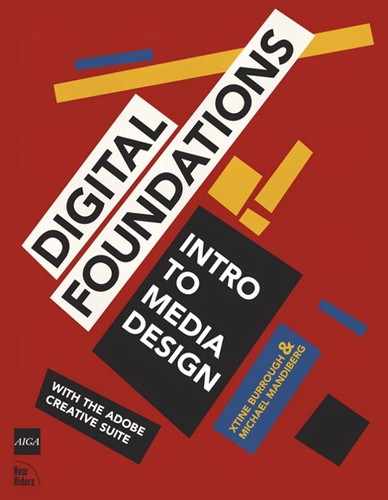This book was written by two artist educators who teach digital art and design studio foundation classes. While teaching classes that take place in software laboratories, we noticed that many of our students expected to learn to use software, but gave little consideration to aesthetics or art and design history. A typical first day question is, “Are we going to learn Photoshop in this class?”
At first we were tempted to oblige our students’ thirst for so-called practical knowledge, but we recognize that in the absence of the visual, theoretical, and historical frameworks, practical knowledge is practically useless. To teach our classes, we used the very best of the software training manuals, and supplemented them with all the visual and historical material that was missing.
After settling for years on books that don’t really encapsulate a class, we finally decided to write the book that we think all introductory media design students should be using. For us, a student is anyone actively engaged in learning. A student can be working towards a degree in art, communication, graphic design, illustration, and so on in a traditional classroom setting, or a self-taught found-it-on-the-bookstore-shelf learner.
In the twenty chapters that follow, we have shared small bites of history, followed by visual references, and then digital exercises that explore Adobe’s Creative Suite in a manner that brings design principles into the software demo.
This book is a mash-up of the Bauhaus Basic Course and the Adobe Creative Suite. We have taken some of the visual principles and exercises from the Bauhaus Basic Course and adapted them into exercises for the Adobe Creative Suite.
The Bauhaus was an influential art, design, and architectural school in Germany. It operated from 1919 to 1933, during which time it transformed art education, through its integration of art, craft, architecture, and design, its emphasis on modern materials, and the creation of the Basic Course. The Basic Course was a year-long course in which first year students learned composition, color theory, and how to use a variety of basic materials. When many of the instructors fled Nazi Germany, arriving in the United States and other countries, they brought this education model with them in the guise of the Studio Foundation course.
This book takes its inspiration from the Bauhaus model.
The exercises in this book explore the core principles of the Adobe Creative Suite design applications. The focus is on core principles that do not change with every software or operating system version, rather than the “new bells and whistles” marketing devices intended to sell new versions of the product.
While we have written this book using Adobe Creative Suite 4 on Mac OS 10.5, we have written the book to be version-independent. We expect that this book will still be just as useful if you were using Adobe Creative Suite 2 on Windows XP, Photoshop 7 on Mac OS 9, or future versions of the software that will be released in the years to come. Our screen shots are from CS4, but you can find the full set of screen shots for CS3 on the wiki at http://wiki.digital-foundations.net.
Within this book we refer to all keyboard shortcuts using the MacOS protocol. If you are using this book with Windows, simply translate the Command key to the Control key and the Option key to the Alt key. Everything else remains the same.
We wrote the entire book online at http://wiki.digital-foundations.net and we will be leaving the text online for anyone to use, for free. You will find our exercise files and any work files that you need to download while working on the exercises in this book at the wiki site. You can download all exercise files from the “Download work files” link, and you can also find work files at the start of each chapter online.
Digital Foundations: Introduction to Media Design with the Adobe Creative Suite is licensed under a Creative Commons Attribution Non-Commercial 3.0 License 2009 by xtine burrough and Michael Mandiberg.
This means that anyone can reprint, reuse, remix and build upon this work non-commercially. This includes translating the book (via the wiki) into other languages, operating systems, or software packages; making screen-casts of each chapter; and augmenting the book with appendixes of visual examples. We encourage you to tag your reprint, reused, and remixed adaptations “digital-foundations” and let us know about your work by emailing us at [email protected].
Commercial (for profit) permissions beyond the scope of this license may be available at http://wiki.digital-foundations.net/index.php?title=Licensing or by contacting [email protected].
